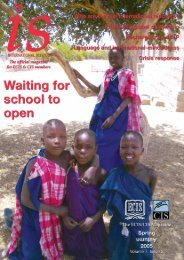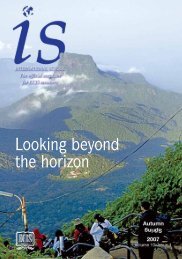is magazine 8.1 - Autumn/Spring 2005 - International Schools ...
is magazine 8.1 - Autumn/Spring 2005 - International Schools ...
is magazine 8.1 - Autumn/Spring 2005 - International Schools ...
Create successful ePaper yourself
Turn your PDF publications into a flip-book with our unique Google optimized e-Paper software.
‘<strong>Schools</strong> and colleges need to<br />
ensure that their teachers and<br />
academic staff have powerful<br />
and user-friendly software to<br />
scan student work effectively<br />
for incidents of plagiar<strong>is</strong>m.<br />
There <strong>is</strong> a wide range of software<br />
available to help teachers<br />
detect plagiar<strong>is</strong>m.’<br />
these resources appropriately. ‘The extent of your responsibility <strong>is</strong><br />
commensurate with the extent of your reach’, said Lowell W.<br />
Monke, a former high school technology teacher and now an<br />
ass<strong>is</strong>tant professor at Grinnell College in Iowa. ‘If we are going to<br />
give kids these very powerful instruments that reach around the<br />
world, we have a real responsibility to teach them how to use<br />
them beneficially’ (Mendels, 2000).<br />
On a more practical and classroom based level, teachers in all<br />
d<strong>is</strong>ciplines need to take on the responsibility of including in their<br />
teaching programmes specific lessons on the correct procedures<br />
for students to cite sources and develop bibliographies to accurately<br />
l<strong>is</strong>t their sources. <strong>Schools</strong> cannot assume that students are<br />
well-versed in these procedures and will automatically use them<br />
when undertaking research assignments.<br />
Additionally, teachers should direct students to resources<br />
which simplify th<strong>is</strong> often complex exerc<strong>is</strong>e. Ironically, when one<br />
considers how the internet has contributed to the explosion of<br />
plagiar<strong>is</strong>m, it <strong>is</strong> through sites such as ‘noodlebib tools’, a bibliographical<br />
tool found on the net, that the mysteries of correct citation<br />
have been greatly reduced.<br />
Detection and sanction<br />
<strong>Schools</strong> and colleges need to ensure that their teachers and academic<br />
staff have powerful and user-friendly software to scan student<br />
work effectively for incidents of plagiar<strong>is</strong>m. There <strong>is</strong> a wide<br />
range of software available to help teachers detect plagiar<strong>is</strong>m.<br />
Many commercial sites offer free trial versions of their software<br />
while some schools and colleges are creating pathfinders to locate<br />
effective detection software. ISKL, for example, has recently purchased<br />
access to a service known as ‘turnitin.com’ as its major<br />
detection instrument.<br />
There will be a phased introduction to th<strong>is</strong> on-line detection<br />
service and currently high school departments are receiving onsite<br />
training in setting up and using the program for their classes.<br />
Ironically the ultimate plan <strong>is</strong> to train students to submit their<br />
work to the system to check for plagiar<strong>is</strong>m prior to forwarding it<br />
to teachers for grading.<br />
Another component of the detection and sanctions platform <strong>is</strong><br />
supporting educators with an appropriate Acceptable Users<br />
Policy (AUP), such that it specifically addresses the <strong>is</strong>sues of plagiar<strong>is</strong>m<br />
and copyright of material downloaded from the internet.<br />
Admin<strong>is</strong>trators need to support the classroom programs with<br />
clear definitions of what constitutes plagiar<strong>is</strong>m and information<br />
relating to copyright restrictions.<br />
At ISKL the <strong>is</strong>sue of plagiar<strong>is</strong>m comes under the heading of<br />
‘Academic D<strong>is</strong>honesty’ in our Student Behavior Guidelines and<br />
there are specific sanctions to deal with such incidents. Clearly<br />
establ<strong>is</strong>hed sanctions cons<strong>is</strong>tent with ex<strong>is</strong>ting school behavior<br />
policies need to be developed to reinforce these aspects of inappropriate<br />
use of technology. These need to be enforced and given<br />
an appropriate profile to ensure that the students and broader<br />
<strong>is</strong> <strong>Autumn</strong> <strong>2005</strong><br />
<strong>Spring</strong><br />
school community are fully aware of the responsible access and<br />
use of electronic information.<br />
For educational institutions to tackle plagiar<strong>is</strong>m effectively<br />
there clearly needs to be a broad approach which addresses not<br />
only the root causes but works at developing in students an<br />
awareness of the ethics of learning. Educators must help students<br />
to real<strong>is</strong>e that ex<strong>is</strong>ting reference sources, whether electronic or<br />
hard copy, are the intellectual property of the legitimate authors<br />
or creators.<br />
Our goal as learners <strong>is</strong> to use these ideas, concepts, processes or<br />
pieces of knowledge and to reflect, adapt or apply these to suit<br />
our needs; while at the same time acknowledging their sources to<br />
legitimize our own credibility as learners and scholars.<br />
Originality comes through the adaptation or extension of ex<strong>is</strong>ting<br />
knowledge and students need th<strong>is</strong> concept to be reinforced as<br />
a key component of their ethics of learning.<br />
Grant Millard <strong>is</strong> High School Ass<strong>is</strong>tant Principal at The<br />
<strong>International</strong> School of Kuala Lumpur, Malaysia.<br />
Bibliography<br />
Baard, M. (2001, August 30). Wireless PC’s :Not just for cheats.<br />
Retrieved April 4, 2004, from http://www.wired.com<br />
Borden, J. (2003). Confucius Meets Piaget (Rev<strong>is</strong>ed ed.). Seoul,<br />
Korea: Author. (Original work publ<strong>is</strong>hed 2000<br />
Bowman, V. (2002, March). The Campaign Against Plagiar<strong>is</strong>m:<br />
Academic Initiatives. LIRT, 12.<br />
Dean, K. (2001, August 9). Plagiar<strong>is</strong>ts Booted; Others Wait.<br />
Retrieved April 6, 2004, from http://www.wired.com<br />
Dornin, R. (1999, November 21). Internet Watchdog Could Stop<br />
Collegiate Copycat. Retrieved October 14, 2004, from CNN Web<br />
site: http://www.cnn.com<br />
Friedman, E. A., & McGrath, B. (1998, September 30). The<br />
Internet <strong>is</strong>n’t a Threat to Students. Retrieved April 4, 2004, from<br />
The Archives Web site: http://www.edweek.org<br />
Mendels, P. (2000, February 16). Online Ethics Should Begin in the<br />
Classroom. Retrieved April 14, 2004, from The York Times Web<br />
site: http://www.nytimes.com<br />
Norr, H. (1999, September 9). Homework Copycats Prosper on the<br />
Net. Retrieved April 6, 2004, from San Franc<strong>is</strong>co Chronicle<br />
Web site: http://www.sfgate.com<br />
‘For educational institutions<br />
to tackle plagiar<strong>is</strong>m effectively<br />
there clearly needs to be a<br />
broad approach which addresses<br />
not only the root causes<br />
but works at developing in<br />
students an awareness of the<br />
ethics of learning. Educators<br />
must help students to real<strong>is</strong>e<br />
that ex<strong>is</strong>ting reference sources,<br />
whether electronic or hard<br />
copy, are the intellectual<br />
property of the legitimate<br />
authors or creators.’<br />
Plagiar<strong>is</strong>m<br />
39




